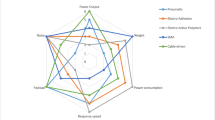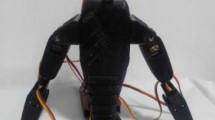Abstract
In service robotics, control systems allowing for skillful manipulation and dexterity constitute one of the most valuable technologies. Recently, control approaches inspired by humans or animals have attracted widespread attention, due to their merit of allowing various tasks to be performed naturally without precisely calculating their behaviors. This work, thus, focuses on the embodiment of a notable control method for a multi-DOF robotic system considering a human physical activity. In contrast to the traditional approaches, in the proposed control, the linear superposition of four control terms is exploited. These consist of joint spring-damping and virtual spring-damper terms in the joint and Cartesian spaces, respectively. Remarkably, the joint spring term is newly designed for the consideration of the simple passive muscle stiffness effect under gravity to guarantee motion repeatability and avoid the problem of ill-posedness. In the experiment, various abilities with respect to position control and compliant behavior are exposed through a real robot. Additional experiments are performed for the verification of the motion repeatability and energy-efficient motion under DOF redundancy.










Similar content being viewed by others
References
Latash ML (1998) Neurophysiological basis of movement. Human Kinetics Publishers, New York
Nakamura Y, Hanafusa H, Yoshikawa T (1987) Task-priority based redundancy control of robot manipulators. Int J Robot Res 6(2):3–15
Hollerbach JM, Suh KC (1987) Redundancy resolution of manipulators through torque optimization. IEEE J Robot Autom 3(4):308–316
Khatib O (1987) A unified approach for motion and force control of robot manipulators: the operational space formulation. IEEE J Robot Autom 3(1):43–53
Seraji H (1989) Configuration control of redundant manipulators: theory and implementation. IEEE J Robot Autom 5(4):472–490
Siciliano B (1990) A closed-loop inverse kinematic scheme for on-line joint-based robot control. Robotica 8:231–243
Arimoto S, Sekimoto M, Bae J-H, Hashiguchi H (2005) Three-dimensional multi-joint reaching under redundancy of DOF. In: Proceedings of the IEEE/RSJ international conference on intelligent robots and systems, pp 1898–1904
Yang W, Chong NY, Kwon J, You BJ (2008) Self-sustaining rhythmic arm motions using neural oscillators. In: Proceedings of the IEEE/RSJ international conference on intelligent robots and systems, pp 3585–3590
Yang W, Bae J-H, Kwon J, Chong NY, Oh Y, You BJ (2009) Self-adapting robot arm movement employing neural oscillators. In: Proceedings of the IEEE/RSJ international conference on intelligent robots and systems, pp 2235–2242
Dietrich A, Ott C, Albu-Schaffer A (2013) Multi-objective compliance control of redundant manipulators: hierarchy, control, and stability. In: Proceedings of the IEEE/RSJ international conference on intelligent robots and systems, pp 3043–3050
Kamiya Y, Asahi T, Ando S, Khatib O (2013) Task oriented control with constraints for industrial robot. In: Proceedings of the 44th international symposium on robotics, pp 1–6
Flacco F, De Luca A (2014) A reverse priority approach to multi-task control of redundant robots. In: Proceedings of the IEEE/RSJ international conference on intelligent robots and systems, pp 2421–2427
Sadeghian H, Villani L, Keshmiri M, Siciliano B (2014) Task-space control of robot manipulators with null-space compliance. IEEE Trans Robot 30(2):493–506
Whitney DE (1969) Resolved motion rate control of manipulators and human prostheses. IEEE Trans Man Mach Syst 10(2):47–53
Liegeois A (1977) Automatic supervisory control of the configuration and behavior of multibody mechanisms. IEEE Trans Syst Man Cyber 7(12):868–871
Yoshikawa T (1985) Manipulability of robotic mechanisms. Int J Robot Res 4(2):3–9
Nakamura Y, Hanafusa H (1986) Inverse kinematic solutions with singularity robustness for robot manipulator control. ASME J Dyn Syst Meas Control 108:163–171
Burdick JW (1989) On the inverse kinematics of redundant manipulators: characterization of the selfmotion manifolds. In: Proceedings of the IEEE international conference on robotics and automation, pp 264–2710
Sicilianno B (1990) Kinematic control of redundant robot manipulators: a tutorial. J Intell Robot Syst 3:201–212
Sciavicco L, Siciliano B (1988) A solution algorithm to the inverse kinematic problem for redundant manipulators. Int J Robot Autom 4(4):403–410
Nakamura Y (1991) Advanced robotics: redundancy and optimization. Addison-Wesley Longman Publishing, Boston
Tarokh M, Kim M (2007) Inverse kinematics of 7-DOF robots and limbs by decomposition and approximation. IEEE Trans Robot 23(3):595–600
Nakanishi J, Cory R, Mistry M, Peters J, Schaal S (2005) Comparative experiments on task space control with redundancy resolution. In: Proceedings of the IEEE/RSJ international conference on intelligent robots and systems, pp 1575–1582
Arimoto S, Sekimoto M, Hashiguchi H, Ozawa R (2005) Natural resolution of ill-posedness of inverse kinematics for redundant robots: a challenge to Bernstein’s degrees-of-freedom problem. Adv Robot 19(4):401–434
Arimoto S, Sekimoto M, Ozawa R (2005) A challenge to Bernstein’s degrees-of-freedom problem in both cases of human and robotic multijoint movements. IEICE Trans Fund Electron Commun Comp Sci E88–A(10):2484–2495
Arimoto S, Hashiguchi H, Sekimoto M, Ozawa R (2005) Generation of natural motions for redundant multi-joint systems: a differential-geometric approach based upon the principle of least actions. Int J Robot Syst 22(11):583–605
Sekimoto M, Arimoto S (2006) Experimental study on reaching movements of robot arms with redundant DOFs based upon virtual spring-damper hypothesis. In: Proceedings of the IEEE/RSJ international conference on intelligent robots and systems, pp 562–567
Sekimoto M, Arimoto S (2007) Experimental study on control method for robot arms with redundant joints based upon virtual spring-damper hypothesis. J Robot Soc Jpn 25(5):785–791 (in Japanese)
Bhattacharjee T, Oh Y, Bae J-H, Oh S-R (2011) Control design for human-like reaching movements using redundancy in robot arm–trunk systems. Int J Cont Autom Syst 9(6):1173–1186
Suzuki M (2013) Generalization of Bernstein’s problem toward autonomous action development of artificial muscle based robots. In: Proceedings of the IEEE European control conference, pp 2292–2298
Acknowledgments
The research was partially supported by the Ministry of Trade, Industry & Energy and the Korea Evaluation Institute of Industrial Technology (KEIT) with the program number of “10038660” and also by the Global Frontier R&D Program on \(<\)Human-centered Interaction for Coexistence\(>\) funded by the National Research Foundation of Korea Grant funded by the Korean Government (MSIP) (2013M3A6A3079228)
Author information
Authors and Affiliations
Corresponding author
Rights and permissions
About this article
Cite this article
Bae, JH., Park, JH., Oh, Y. et al. Task space control considering passive muscle stiffness for redundant robotic arms. Intel Serv Robotics 8, 93–104 (2015). https://doi.org/10.1007/s11370-015-0165-2
Received:
Accepted:
Published:
Issue Date:
DOI: https://doi.org/10.1007/s11370-015-0165-2




